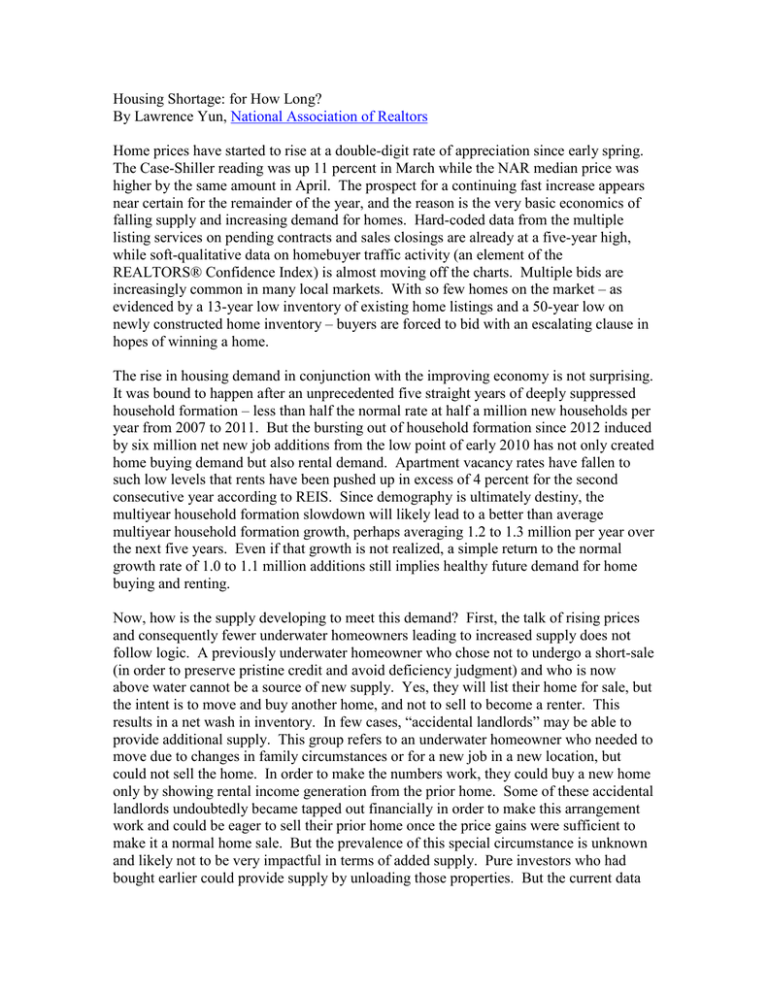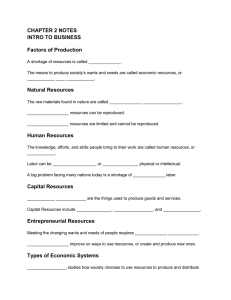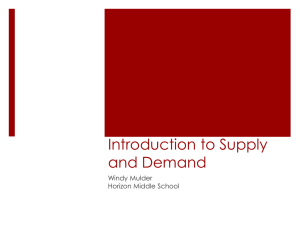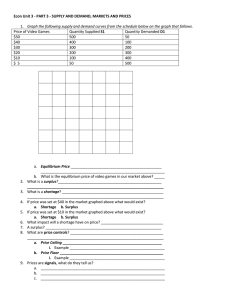Housing Shortage: for How Long? ,
advertisement

Housing Shortage: for How Long? By Lawrence Yun, National Association of Realtors Home prices have started to rise at a double-digit rate of appreciation since early spring. The Case-Shiller reading was up 11 percent in March while the NAR median price was higher by the same amount in April. The prospect for a continuing fast increase appears near certain for the remainder of the year, and the reason is the very basic economics of falling supply and increasing demand for homes. Hard-coded data from the multiple listing services on pending contracts and sales closings are already at a five-year high, while soft-qualitative data on homebuyer traffic activity (an element of the REALTORS® Confidence Index) is almost moving off the charts. Multiple bids are increasingly common in many local markets. With so few homes on the market – as evidenced by a 13-year low inventory of existing home listings and a 50-year low on newly constructed home inventory – buyers are forced to bid with an escalating clause in hopes of winning a home. The rise in housing demand in conjunction with the improving economy is not surprising. It was bound to happen after an unprecedented five straight years of deeply suppressed household formation – less than half the normal rate at half a million new households per year from 2007 to 2011. But the bursting out of household formation since 2012 induced by six million net new job additions from the low point of early 2010 has not only created home buying demand but also rental demand. Apartment vacancy rates have fallen to such low levels that rents have been pushed up in excess of 4 percent for the second consecutive year according to REIS. Since demography is ultimately destiny, the multiyear household formation slowdown will likely lead to a better than average multiyear household formation growth, perhaps averaging 1.2 to 1.3 million per year over the next five years. Even if that growth is not realized, a simple return to the normal growth rate of 1.0 to 1.1 million additions still implies healthy future demand for home buying and renting. Now, how is the supply developing to meet this demand? First, the talk of rising prices and consequently fewer underwater homeowners leading to increased supply does not follow logic. A previously underwater homeowner who chose not to undergo a short-sale (in order to preserve pristine credit and avoid deficiency judgment) and who is now above water cannot be a source of new supply. Yes, they will list their home for sale, but the intent is to move and buy another home, and not to sell to become a renter. This results in a net wash in inventory. In few cases, “accidental landlords” may be able to provide additional supply. This group refers to an underwater homeowner who needed to move due to changes in family circumstances or for a new job in a new location, but could not sell the home. In order to make the numbers work, they could buy a new home only by showing rental income generation from the prior home. Some of these accidental landlords undoubtedly became tapped out financially in order to make this arrangement work and could be eager to sell their prior home once the price gains were sufficient to make it a normal home sale. But the prevalence of this special circumstance is unknown and likely not to be very impactful in terms of added supply. Pure investors who had bought earlier could provide supply by unloading those properties. But the current data still implies high investor demand interest because of reasonable rental yields in comparison to other alternative assets. The prospect of net dumping by the investor class is not in the cards this year. A genuine way to increase supply is from new home construction. Housing starts fell to historic lows over multiple years during the housing market crash. The decline was certainly justifiable initially to compensate for over-building during the bubble years. However, my estimate suggests we have already overcompensated and are facing a housing shortage to the tune of 900,000 million. That is, cumulatively from 2001 to 2012, there were 15.7 million housing starts while household formation, plus the need to replace demolished units, reached 16.8 million (2001 was chosen for the beginning year since it was a non-eventful and very normal year for the housing market). If household formation is 1 million with 300,000 demolished/uninhabitable units in 2013 and 100,000 in new demand for vacation homes — a reasonable and conservative assumption — then 1.5 million housing starts would be needed just to keep even this year without solving the previously accumulated shortage. This year’s consensus economist forecast on housing starts estimate is around 1 to 1.1 million. So the shortage situation looks only to worsen. The table below shows alternative scenarios of new demand and new supply in the upcoming years. If, for example, housing starts only gradually reach 1.5 million by 2015 as most economists are projecting, then the housing shortage remains acute over the next two years. On the other hand, if housing starts quickly bounce back to 1.6 million by 2014 and to 1.9 million by 2015 then most of the shortages would be eliminated. Only in this type of scenario can we expect a measurable moderation in home price growth by 2015. The most other scenarios are hinting at solid above-average price growth, possibly in the high single-digit annual rates of appreciations, over the next three years. Scenario 1 of housing starts rising to 1.5 million by 2015 Household Demolition Housing Housing formation and second Demand Supply home demand 2001 to 11.0 million 5.6 million 16.6 15.7 2012 million million 2013 1.0 million 400,000 1.4 1.1 million million 2014 1.0 million 400,000 1.4 1.3 million million 2015 1.0 million 400,000 1.4 1.5 million million Shortage Cumulative Housing Shortage 900,000 900,000 300,000 1.2 million 100,000 1.3 million -100,000 1.2 million Scenario 2 of housing starts rising to 1.7 million by 2015 Household formation 2001 to 2012 2013 Demolition and second home demand 11.0 million 5.6 million 1.0 million 400,000 2014 1.0 million 400,000 2015 1.0 million 400,000 Housing Demand Housing Supply Shortage/ Surplus Cumulative Housing Shortage 16.6 million 1.4 million 1.4 million 1.4 million 15.7 million 1.1 million 1.5 million 1.7 million 900,000 900,000 300,000 1.2 million -100,000 1.1 million -300,000 0.8 million Scenario 3 of housing starts rising to 1.9 million by 2015 Household formation 2001 to 2012 2013 Demolition and second home demand 11.0 million 5.6 million 1.0 million 400,000 2014 1.0 million 400,000 2015 1.0 million 400,000 Housing Demand Housing Supply Shortage/ Surplus Cumulative Housing Shortage 16.6 million 1.4 million 1.4 million 1.4 million 15.7 million 1.1 million 1.6 million 1.9 million 900,000 900,000 300,000 1.2 million -200,000 1.0 million -500,000 0.5 million




